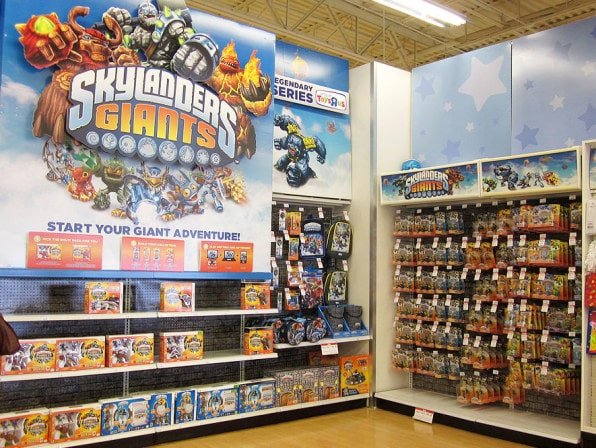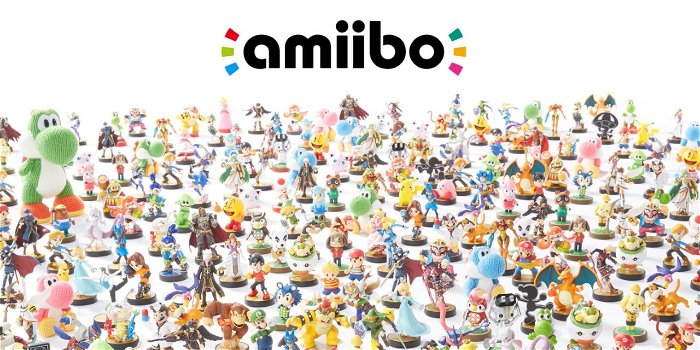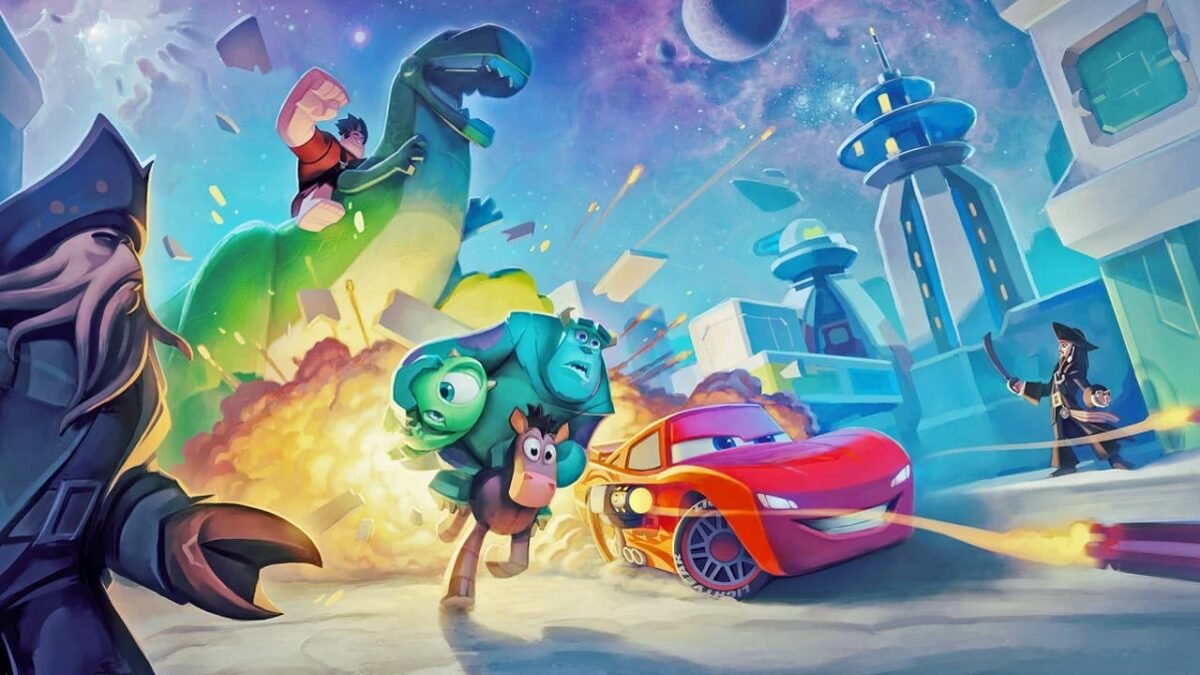The toys-to-life fad hit the games industry like a hurricane and consumed store shelves around a decade ago, but dwindled as quickly as it came.
In 2011, a new game called Skylanders appeared on the scene, inviting kids to purchase a pile of figurines, place them on a portal accessory plugged into their game console, and use those toy characters as playable characters in the digital world. The toys-to-life game fad that followed staked a claim in the industry—and a vast swath of game stores’ space—for the better part of the decade.
Then, due to a variety of factors like decreasing physical game sales, frustration from retailers and parents who had no more space for “these damn things,” and just general apathy, the genre essentially vanished. (Well, not entirely; your friendly local retro gaming store likely still has a bin of discarded plastic bits in the corner.)
Ten years after the rise of the toys-to-life genre, let’s look back at five of the most prominent examples of the trend, and why they eventually collapsed.
5. Starlink: Battle for Atlas
Despite being one of the more serious gameplay experiences of the genre, Ubisoft’s foray into toys-for-life never quite broke free of the stratosphere. Starlink: Battle for Atlas launched in late 2018, at the end of the fad and well after stronger competitors had thrown in the towel. Believing they could revive the genre, Ubisoft launched an action-adventure game where players flew around in space or in atmosphere, with the option to customize their in-game ship by changing the configuration of the physical toys.
To make it more accessible, the toy element was essentially optional, and the game was playable without using them at all—in a way undermining the need for the toys-to-life element whatsoever. The Nintendo Switch version came with a StarFox starter set, attempting to use Nintendo’s prestige to move copies. However, the actual main characters of Starlink were only available by buying the PS4 or Xbox One starters, so an exclusive incentive for one system actually created a need to buy the game on another system altogether, essentially negating most of its own value.
Though it fared well critically, Ubisoft’s sales predictions were not met and production for new Starlink figures was ultimately shut down in April 2019, only six months after launch.
4. LEGO Dimensions
LEGO sets have been popular for decades, and LEGO games are generally well-received by critics and fans alike, so mashing the two together as a toys-to-life platform should have been a slam dunk, right? On paper, it was, but in reality LEGO Dimensions did not fare quite as well.
The concept was fairly simple: build the physical toys and scan them into the game to use that character/vehicle in a sort of “greatest hits” campaign of LEGO games. Warner Bros. licenses like DC superheroes, Back to the Future, The Lego Movie, Scooby-Doo, The Simpsons, and Ghostbusters were present, to name a few, and were available through various forms: story, level, team, and fun packs.
As LEGO Dimensions came later in the toys-to-life fad, Traveller’s Tales was able to learn from some competitors’ mistakes when it came to game design, implementing figures to “borrow” characters the player did not own. However, compared to the sprawling rosters included in other LEGO games, Dimensions felt like hiding characters behind pay-walls. Sure, an actual toy was behind that wall too, but it did affect the game’s staying power.
After two years, LEGO Dimensions was soft-terminated in October 2017, a year ahead of plan. A year’s worth of content, including the story’s grand finale, was left unreleased. While the game was a relative success, internal sources blamed the poor performance of more obscure sets for dragging down the whole—a side effect of throwing all the licensing spaghetti at the wall to see what sticks. Younger players liked the more familiar characters, but their parents weren’t as intrigued to grab a niche character from their own youth and join in.
3. Skylanders

The game that truly invented the toys-to-life movement is, fittingly, one of its most successful, becoming another huge bullet on Activision Blizzard’s financial reports for a time. Imagined as a roundabout way of reviving the Spyro the Dragon franchise, Skylanders set the precedent for this movement of console games and was the longest-running game series among them—spanning six games from 2011-2016; hundreds of figurines and pieces; a three-season cartoon starring the likes of Justin Long, Norm McDonald, and Johnathan Banks; and over $3 billion in revenue.
The first game, Spyro’s Adventure, was a middling success with critics but planted a flag firmly enough. Its sequel, Giants, was a more stable experience and earned a better reaction, and the franchise made $1 billion within a year and a half. Developer Toys For Bob changed up the formula with each iteration, but diminishing returns set in over time; parents’ complaints about the cost of figures started early and never disappeared over time, and as competitors rose and fell in its shadow, so too did demand for the progenitor franchise. Ironically, the last main game Imaginators came out on Switch and didn’t require the bulky portal, but this innovation came too late.
Skylanders essentially fizzled out, much like the toys-to-life genre itself. However Activision Blizzard never declared the series dead, unlike Ubisoft’s Starlink or our next example, and Microsoft is reportedly interested in exploring a revival post-merger. (Microsoft certainly has the financial backing to support producing and distributing these figurines again, but I have a bad feeling that a new toys-to-life franchise in today’s industry would somehow involve NFTs.)
2. Disney Infinity

Disney Infinity took the flashy license recognition of LEGO Dimensions and a capacity to produce toys that Skylanders could not rival, added an element of LittleBigPlanet-style creation, and nearly dominated the entire toys-to-life trend. However, it also served as the canary in the coal mine.
Launching in August 2013 with a smattering of Disney-Pixar sandboxes, Disney Infinity offered arguably one of the best experiences in the genre. Playsets offered two figures and a themed-campaign mode, with other characters available individually; on-theme characters could be used in their related campaign, while many other characters were just available in non-themed or user-made content. The figures weren’t playable outside the game, unlike LEGO’s offering, but it was also a more streamlined business model… for a genre that encouraged heavy additional spending, at least.
The second game added Marvel sets to the mix, and the third added Star Wars. The whole enterprise was bolstered by Disney’s box office successes—figures for Anna, Elsa, and Olaf appeared while the whole world was still singing “Let It Go,” and Disney Infinity 3.0 coincided nicely with the release of The Force Awakens. However, the whole enterprise was ended prematurely when Disney decided to cease self-publishing console games in 2016. While downward-trending sales in the toys-to-life sector played a role, it was a decision made for the larger company, not for the quality of the game itself.
A fourth game and several sets and figures in development never saw the light of day—including Moana, and Belle and the Beast in live-action-remake designs. Given Disney’s box office dominance, it’s likely Disney Infinity could have gone beyond for much longer than it did, or maybe even still remain in operation today. Instead it was thrown out with the bath water, and ultimately shook the industry’s faith in the toys-to-life genre.
1. Amiibo

As the only line on this list that’s still releasing new figures as of this writing—the Super Smash Bros. figures for Steve and Alex dropped alongside Splatoon 3 and new Inkling figures last week—Nintendo’s Amiibo stand as the victor of the toys-to-life arms race.
That’s odd in a lot of ways, considering Nintendo barely made any software that revolved around the figures fundamentally. Even Animal Crossing Amiibo Festival did not require them, despite its name. Instead, these figures have served as a bonus for Nintendo’s faithful, typically unlocking unique cosmetics or extra items depending on the game that supports them.
One thing that’s keeping the line alive is Nintendo’s promise to release a figure for each playable character in Super Smash Bros. Ultimate. (Smash coincidentally uses Amiibo in the most interesting way, allowing players to train AI fighters of their favourite characters, so it’s fitting that Smash is the thing keeping them alive.) Come this time next year, the final fighter should have received his figure, and then the future of the last-standing toys-to-life franchise looks uncertain.
Since the first figures released in November 2014, Nintendo has kept Amiibo alive by following the ideal toys-to-life strategy: it offered nice-looking toys that served enticing but unessential functions over various games, without flooding the market or stores with bulky inventory—and in the process, maintaining an aura of rarity and mystique that has preserved the toys’ value over time. (Okay, maybe the Animal Crossing line was overproduced, but by-and-large, Nintendo avoided this problem.)
Now that my own kids are getting into video games, the parent in me is glad the temptation to gather so many expensive pieces of plastic has faded, but the gamer in me is disappointed that the toys-to-life phase has essentially fizzled out. For a time, the genre bridged the gap between traditional and digital play in some novel ways. Instead, maybe I can compromise and just feel relief for the game store employees who no longer have to cram so many bulky products onto shelves.




